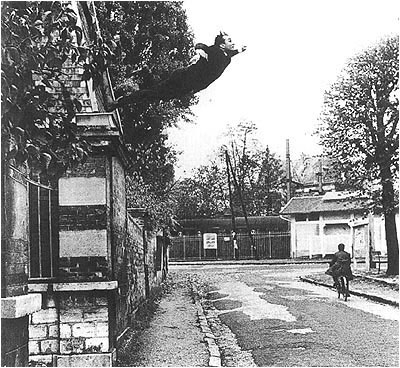In 1960 Yves Klein published a photo of himself floating in the air, apparently after jumping out of a window. The composition was thorough and you could see both the window and the pavement, both essential to accomplish the desired effect.
The subject is located at a point in which he can either be falling or rising. In spite of the general opinion, I do not think that the artist was trying to convince us that he is jumping out the window, but that he is capable of establishing an harmonic –but also aesthetic- relationship between him and the air.
 |
Yves
Klein was one of the prophets of the dematerialization of art. In parallel his discourse and his work put in practice the aesthetics of the immaterial, the poetry of the aerial, and the semantics of space. That is how I understand his emphasis in space as a goal of artistic sensitivity. In his Chelsea Hotel Manifesto he states: “Man will only be capable of conquering space after impregnating it with his own sensitivity”1.
|
The picture of “jumping into the void” can be read as the document of an extreme gesture of the impregnation of artistic sensitivity in space. You could think that is the reason why the critics and art history have devoted so much attention to it. However, there are also reasons to suspect that the most attractive elements to comment on the relevance of the image are its character of both spectacle and simulation.
Yves Klein tried to make a photomontage believable, but he also reproduced it and distributed widely as flyers. From a Post Modern point of view, these actions would truly be considered as artistic genius, and that would be the place to look for aesthetic effectiveness. From that standpoint, the photo would not be working, as a document of an ephemeral, even immaterial work, since such immateriality would lay in the fact that such “jump from the window” never really happened. Therefore, the work consists in the appropriation and unfolding of a mechanism of collective persuasion. And specially, in the exhibition of that mechanism, even when such exhibition was not completely foreseen by the artist.
This work has a very relevant role in the photographic medium. In fact, Yves Klein produced a piece that sums up the relationship between contemporary photography and art in the context of mass culture. This piece marks the place of photography within Post Modern art and the social impact of mass media as a means of persuasion.
1. This manifesto was written by Klein in New York in 1961, when he has his first solo exhibition sponsored by Leo Castelli. The sentence in question is directed to defend a humanist and spiritual model that already was in crisis before the thrust of the scientist and technocratic utopia derived from the developed Capitalism, specially in the post-war years euphoria of the USA: “Neither missiles nor rockets nor sputniks will render man the "conquistador" of space. Those means derive only from the phantom of today's scientists who still live in the romantic and sentimental spirit of the XIX century. Man will only be able to take possession of space through the terrifying forces, the ones imprinted with peace and sensibility. He will be able to conquer space - truly his greatest desire - only after having realized the impregnation of space by his own sensibility. His sensibility can even read into the memory of nature, be it of the past, of the present, and of the future!”


